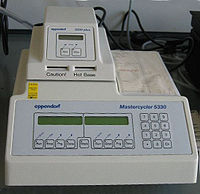
Thermal cycler
Encyclopedia

Laboratory
A laboratory is a facility that provides controlled conditions in which scientific research, experiments, and measurement may be performed. The title of laboratory is also used for certain other facilities where the processes or equipment used are similar to those in scientific laboratories...
apparatus used to amplify segments of DNA
DNA
Deoxyribonucleic acid is a nucleic acid that contains the genetic instructions used in the development and functioning of all known living organisms . The DNA segments that carry this genetic information are called genes, but other DNA sequences have structural purposes, or are involved in...
via the polymerase chain reaction
Polymerase chain reaction
The polymerase chain reaction is a scientific technique in molecular biology to amplify a single or a few copies of a piece of DNA across several orders of magnitude, generating thousands to millions of copies of a particular DNA sequence....
(PCR) process. The device has a thermal block with holes where tubes holding the PCR reaction mixtures can be inserted. The cycler then raises and lowers the temperature of the block in discrete, pre-programmed steps.
The earliest thermal cyclers were designed for use with the Klenow fragment
Klenow fragment
right|thumb|450px|Functional domains in the Klenow Fragment and DNA Polymerase I .The Klenow fragment is a large protein fragment produced when DNA polymerase I from E. coli is enzymatically cleaved by the protease subtilisin...
of DNA Polymerase I
DNA polymerase I
DNA Polymerase I is an enzyme that participates in the process of DNA replication in prokaryotes. It is composed of 928 amino acids, and is an example of a processive enzyme - it can sequentially catalyze multiple polymerisations. Discovered by Arthur Kornberg in 1956, it was the first known...
. Since this enzyme is destroyed during each heating step of the amplification process, new enzyme had to be added every cycle. This led to a cumbersome machine based on an automated pipettor, with open reaction tubes. Later, the PCR process was adapted to the use of thermostable DNA polymerase
Taq polymerase
thumb|228px|right|Structure of Taq DNA polymerase bound to a DNA octamerTaq polymerase is a thermostable DNA polymerase named after the thermophilic bacterium Thermus aquaticus from which it was originally isolated by Thomas D. Brock in 1965...
from Thermus aquaticus
Thermus aquaticus
Thermus aquaticus is a species of bacterium that can tolerate high temperatures, one of several thermophilic bacteria that belong to the Deinococcus-Thermus group...
, which greatly simplified the design of the thermal cycler. While in some old machines the block is submerged in an oil bath to control temperature, in modern PCR machines a Peltier element is commonly used. Quality thermal cyclers often contain silver
Silver
Silver is a metallic chemical element with the chemical symbol Ag and atomic number 47. A soft, white, lustrous transition metal, it has the highest electrical conductivity of any element and the highest thermal conductivity of any metal...
blocks to achieve fast temperature changes and uniform temperature throughout the block. Other cyclers have multiple blocks with high heat capacity, each of which is kept at a constant temperature, and the reaction tubes are moved between them by means of an automated process.
Modern thermal cyclers are equipped with a heated lid, a heated plate that presses against the lids of the reaction tubes. This prevents condensation of water from the reaction mixtures on the insides of the lids and makes it unnecessary to use PCR oil to cover the reaction mixture. Some thermal cyclers are equipped with multiple blocks allowing several different PCR
Polymerase chain reaction
The polymerase chain reaction is a scientific technique in molecular biology to amplify a single or a few copies of a piece of DNA across several orders of magnitude, generating thousands to millions of copies of a particular DNA sequence....
reactions to be carried out simultaneously. Also some apparatus have a gradient function, which allows different temperatures in different parts of the block. This is particularly useful when testing suitable annealing temperatures for primer
Primer (molecular biology)
A primer is a strand of nucleic acid that serves as a starting point for DNA synthesis. They are required for DNA replication because the enzymes that catalyze this process, DNA polymerases, can only add new nucleotides to an existing strand of DNA...
s.
Thermal cyclers are traditionally very expensive, and typically cost in the thousands of euros or dollars. However, recent developments in open-source hardware designs, at least one of which is commercially available for purchase, have brought the price down significantly.

